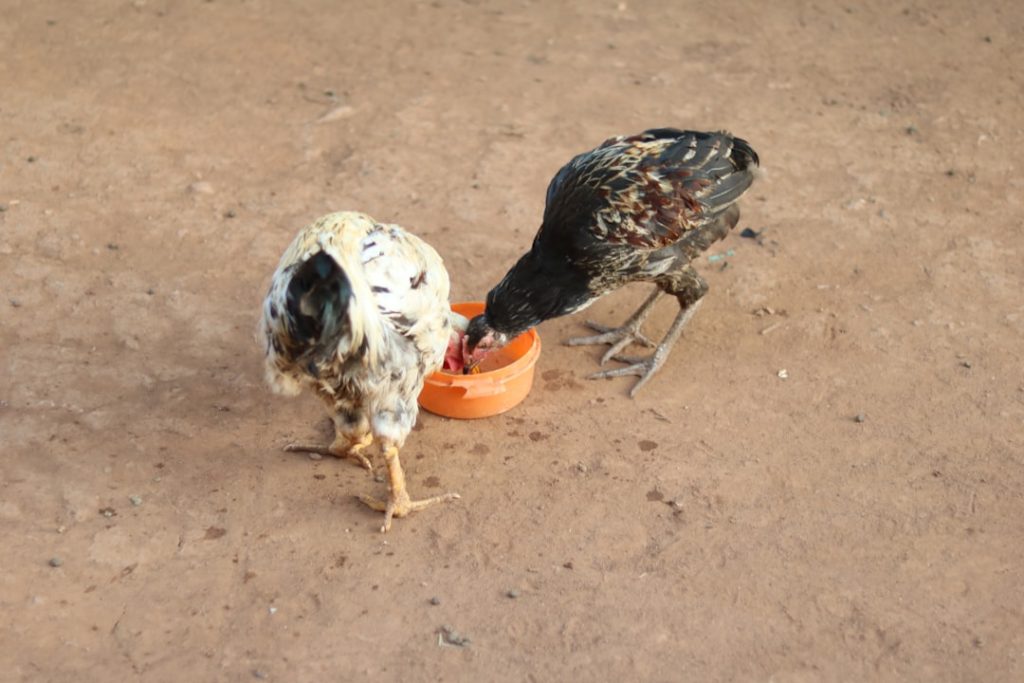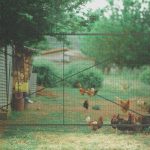Chickens are social creatures that function best in a structured environment. They establish a hierarchical system known as a pecking order, where dominant birds assert authority over subordinate ones. This social structure is an important consideration when designing a watering system for chickens.
These birds are inherently inquisitive and will explore new objects in their surroundings, necessitating sturdy and secure watering equipment to prevent damage or spillage. Chickens also thrive on routine, quickly adapting to regular feeding and watering schedules. Maintaining consistency in water provision is crucial to avoid causing stress or disorientation within the flock.
The drinking habits of chickens are specific to their physiology. They prefer shallow water sources due to their limited ability to lift their heads and swallow. Shallow dishes or troughs are more suitable than deep containers for chicken hydration.
Understanding these natural behaviors and preferences is essential for selecting an appropriate watering system that ensures adequate and comfortable access to water for the flock.
Table of Contents
- 1 Choosing the Right Watering System
- 2 Securing the Watering System
- 3 Providing Adequate Space
- 4 Monitoring and Adjusting
- 5 Training Chickens
- 6 Seeking Professional Advice
- 7 FAQs
- 7.1 What are some ways to keep chickens from knocking over water?
- 7.2 What are some types of waterers that are less likely to be knocked over by chickens?
- 7.3 How can I secure the location of the waterer to prevent chickens from knocking it over?
- 7.4 Are there any behavioral or environmental factors that may contribute to chickens knocking over water?
Key Takeaways
- Chickens have natural behaviors such as scratching, pecking, and dust bathing that should be understood and accommodated in their environment.
- The right watering system for chickens should provide clean and fresh water, be easily accessible, and prevent contamination.
- Securing the watering system is important to prevent spillage, contamination, and to ensure chickens have continuous access to water.
- Providing adequate space for chickens is crucial for their health and well-being, and to prevent overcrowding and aggressive behavior.
- Regular monitoring and adjusting of the watering system, space, and overall environment is necessary to ensure the chickens’ needs are met and to prevent issues.
Choosing the Right Watering System
Types of Watering Systems
When it comes to selecting a watering system for your chickens, there are several options to consider. The most common types of watering systems for chickens include gravity-fed waterers, nipple waterers, and automatic waterers. Gravity-fed waterers are simple and inexpensive, relying on the force of gravity to keep the water flowing into a dish or trough. Nipple waterers, on the other hand, are designed to release water when the chickens peck at the metal nipple, providing a constant supply of fresh water. Automatic waterers are connected to a water source and use a float valve to maintain a consistent water level, ensuring that your chickens always have access to water.
Factors to Consider
When choosing a watering system, it’s essential to consider the size of your flock, the climate in your area, and the amount of time you can dedicate to maintenance. These factors will help you determine which type of watering system is best suited for your needs.
Pros and Cons of Each System
Each type of watering system has its advantages and disadvantages. Gravity-fed waterers are suitable for small flocks and are easy to clean and refill, but they may not be practical for larger flocks or in areas with extreme temperatures. Nipple waterers are more suitable for larger flocks and can help prevent water contamination, but they require regular maintenance to ensure that the nipples are functioning properly. Automatic waterers are ideal for large flocks and can save time on daily maintenance, but they require a reliable water source and may be more expensive to install.
Securing the Watering System

Once you’ve chosen a watering system for your chickens, it’s important to secure it to prevent damage and spillage. Chickens are naturally curious and can be quite destructive, so it’s essential to ensure that the watering system is stable and protected from their pecking and scratching. If you’re using a gravity-fed waterer, consider placing it on a raised platform to keep it out of reach of dirt and debris.
For nipple waterers, make sure they are securely attached to a stable structure to prevent them from being knocked over or damaged by the chickens. It’s also important to protect the watering system from environmental factors such as extreme weather or predators. If your chickens are kept outdoors, consider placing the watering system under a shelter to protect it from rain, snow, and direct sunlight.
You may also need to install a heating element in the winter to prevent the water from freezing. Additionally, if you have predators in your area, such as raccoons or rats, make sure the watering system is secured with a lid or cover to prevent them from contaminating the water or damaging the system.
Providing Adequate Space
In addition to providing a suitable watering system, it’s important to ensure that your chickens have adequate space to access the water. Chickens are social animals and can become aggressive when competing for resources such as food and water. This means that you should provide multiple watering stations to prevent overcrowding and ensure that all of your chickens have access to water.
When determining the number of watering stations needed, consider the size of your flock and the layout of your coop or run. Ideally, there should be at least one watering station for every 10-15 chickens. This will help prevent overcrowding and reduce the risk of dominant birds monopolizing the water supply.
It’s also important to place the watering stations in different areas of the coop or run to encourage movement and prevent congestion around a single location. In addition to providing multiple watering stations, make sure that they are easily accessible for all of your chickens. This means placing them at an appropriate height for different ages and sizes of chickens and ensuring that there are no obstacles blocking their access.
By providing adequate space and multiple watering stations, you can help reduce competition and ensure that all of your chickens have access to clean, fresh water.
Monitoring and Adjusting
Once you’ve established a watering system for your chickens, it’s important to monitor its effectiveness and make adjustments as needed. Regularly check the water supply to ensure that it is clean and free from contaminants such as dirt, debris, or algae. Clean the watering stations regularly to prevent bacterial growth and ensure that the water remains fresh and palatable for your chickens.
It’s also important to monitor the behavior of your chickens around the watering stations. Watch for signs of aggression or competition, such as pecking or crowding around a single station. If you notice any issues, consider adding more watering stations or adjusting their placement to encourage equal access for all of your chickens.
In addition to monitoring the watering stations themselves, pay attention to the water consumption of your flock. A sudden decrease in water consumption could indicate an underlying health issue or environmental stressors. Conversely, an increase in water consumption could be a sign of dehydration or excessive heat.
By monitoring the behavior of your chickens and their water consumption, you can make adjustments to the watering system as needed to ensure that your flock remains healthy and hydrated.
Training Chickens

Gradual Introduction to the New System
Training your chickens to use a new watering system requires time and patience, but it’s essential for ensuring they have access to clean, fresh water. Start by introducing the new system gradually, allowing your chickens to become familiar with it at their own pace. You can do this by placing the new watering station next to their existing one and gradually phasing out the old system once they are comfortable with the new one.
Encouraging Your Chickens to Use the New System
To encourage your chickens to use the new watering system, consider adding treats or incentives near the station to attract their attention. You can also gently guide them towards the new station by tapping on it or placing their beaks near the water source. Positive reinforcement through praise and rewards can also help encourage your chickens to use the new watering system.
Patience and Consistency are Key
It’s essential to be patient during this training process and avoid forcing your chickens to use the new system. Chickens are creatures of habit and may take time to adjust to changes in their environment. By being patient and consistent in your approach, you can help your chickens become comfortable with the new watering system and ensure they have access to clean, fresh water.
Seeking Professional Advice
If you’re unsure about which watering system is best for your flock or how to secure and maintain it properly, don’t hesitate to seek professional advice. Local agricultural extension offices or poultry experts can provide valuable guidance on choosing the right watering system for your specific needs. They can also offer advice on securing the watering system from environmental factors and predators, as well as provide tips on training your chickens to use it effectively.
Professional advice can also be invaluable when it comes to monitoring and adjusting your watering system. If you notice any issues with water quality or consumption, consulting with a professional can help you identify potential causes and make necessary adjustments. They can also provide guidance on best practices for maintaining a clean and reliable water supply for your flock.
In addition to seeking professional advice, consider connecting with other chicken owners in your area or joining online forums and communities dedicated to poultry care. These resources can provide valuable insights and support from experienced chicken owners who have faced similar challenges with their own flocks. By seeking professional advice and connecting with other chicken owners, you can gain valuable knowledge and support for providing a reliable watering system for your chickens.
In conclusion, understanding the behavior of chickens is crucial when designing a watering system for them. Choosing the right watering system involves considering factors such as flock size, climate, and maintenance requirements. Securing the watering system is essential for protecting it from damage and environmental factors.
Providing adequate space and monitoring behavior are important for ensuring equal access to clean water for all chickens. Training chickens to use a new watering system requires patience and positive reinforcement. Seeking professional advice can provide valuable guidance on choosing, securing, maintaining, and adjusting a watering system for chickens.
If you’re looking for ways to keep your chickens from knocking over their water, you may also be interested in learning about the benefits of using a trampoline in your chicken coop. Check out this article on how a trampoline can improve your chicken coop to see how it can provide entertainment and exercise for your flock while also keeping them from spilling their water.
FAQs
What are some ways to keep chickens from knocking over water?
Some ways to keep chickens from knocking over water include using heavy or weighted waterers, placing waterers in a secure location, and using a waterer with a narrow base.
What are some types of waterers that are less likely to be knocked over by chickens?
Some types of waterers that are less likely to be knocked over by chickens include nipple waterers, automatic waterers, and waterers with a weighted or heavy base.
How can I secure the location of the waterer to prevent chickens from knocking it over?
You can secure the location of the waterer by placing it on a raised platform, using a waterer with a narrow base that fits into a stand, or attaching the waterer to a stable structure such as a fence or wall.
Are there any behavioral or environmental factors that may contribute to chickens knocking over water?
Yes, chickens may knock over water due to boredom, overcrowding, or lack of space. Providing enrichment activities, adequate space, and a calm environment can help reduce the likelihood of chickens knocking over water.
Meet Walter, the feathered-friend fanatic of Florida! Nestled in the sunshine state, Walter struts through life with his feathered companions, clucking his way to happiness. With a coop that’s fancier than a five-star hotel, he’s the Don Juan of the chicken world. When he’s not teaching his hens to do the cha-cha, you’ll find him in a heated debate with his prized rooster, Sir Clucks-a-Lot. Walter’s poultry passion is no yolk; he’s the sunny-side-up guy you never knew you needed in your flock of friends!







